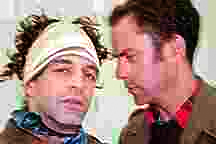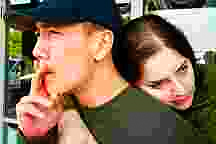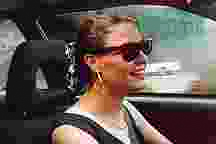| Compression Degradation |
| A series of large digital photographic prints which have been visually disintegrated by the application of an unusually brutal amount of JPEG compression.
Created April 2002 for the Santa Cruz Digital Arts Festival. The prints are 34 x 51 inches. They are intended to be seen as large prints, so an on-screen simulation of the proper scale is included; but this does not replicate the hard-copy meatspace experience. The thumbnails here represent the size of your visual image of the prints at a viewing distance of about 45 feet. Click thumbnail to enlarge; keep clicking to zoom in further (effect does not work in Safari). Here's a mockup of the show in a gallery. Please read the additional info below, and follow the link on mathematics of compression. |
|||||||||||||||||||||||||
 |
|||||||||||||||||||||||||
 |
|||||||||||||||||||||||||
| compression degradation #2 | |||||||||||||||||||||||||
| compression degradation #1 | |||||||||||||||||||||||||
 |
|||||||||||||||||||||||||
 |
|||||||||||||||||||||||||
| compression degradation #4 | |||||||||||||||||||||||||
| compression degradation #3 | |||||||||||||||||||||||||
 |
|||||||||||||||||||||||||
 |
|||||||||||||||||||||||||
| compression degradation #6 | |||||||||||||||||||||||||
| compression degradation #5 | |||||||||||||||||||||||||
| beginning of 2nd series: | |||||||||||||||||||||||||
 |
|||||||||||||||||||||||||
 |
|||||||||||||||||||||||||
| compression degradation #8 | |||||||||||||||||||||||||
| compression degradation #7 | |||||||||||||||||||||||||
| Perversion of Technology
JPEG compression is used daily by millions of people, whether they know it or not. It is the main technology used for minimizing the file size of images on the internet, and of images captured with consumer digital cameras. JPEG (named after the Joint Photographic Experts Group, who developed the standard) is a remarkably effective compression method. File sizes can often be reduced to as little as one fiftieth of the original, with acceptable quality results. The most interesting thing about JPEG is that it is a "lossy" compression scheme; that is, quality is lost in the compression. The more compression one uses, the more degradation occurs in the image. The usual approach of web designers or engineers who use JPEG is to find a balance point where good savings have been achieved in file size (for efficient internet transmission or digital storage), but sufficient image quality has been maintained for the application at hand. --------------------------------------------------------------------------------------------- The pictures do not present a mathematically pure vision of compression algorithms; I have enhanced the color and contrast to accentuate the JPEG artifacts. The prints are 34 x 51 inches on canvas, and were made by Real Color in Santa Cruz, CA with an HP 5000 PS printer. Media and archival pigments donated by Hewlett-Packard for the Santa Cruz Digital Arts Festival. The original files are 216 x 144 pixels. Resolution is 4.235 dpi. A word on the mathematics of compression |
|||||||||||||||||||||||||